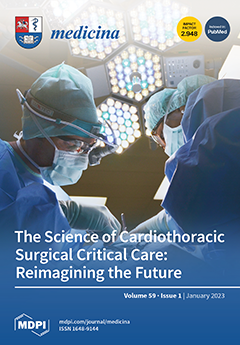Background and Objectives: Transaxillary access is one of the latest innovations for minimally invasive aortic valve replacement (MICS-AVR). This study compares clinical performance in a large transaxillary MICS-AVR group to a propensity-matched sternotomy control group.
Materials and Methods: This study enrolled 908 patients undergoing isolated AVR with a mean age of 69.4 ± 18.0 years, logistic EuroSCORE of 4.0 ± 3.9%, and body mass index (BMI) of 27.3 ± 6.1 kg/m
2. The treatment group comprised 454 consecutive transaxillary MICS-AVR patients. The control group was 1:1 propensity-matched out of 3115 consecutive sternotomy aortic valve surgeries. Endocarditis, redo, and combined procedures were excluded. The multivariate matching model included age, left ventricular ejection fraction, logistic EuroSCORE, pulmonary hypertension, coronary artery disease, chronic lung disease, and BMI.
Results: Propensity-matching was successful with subsequent comparable clinical baselines in both groups. MICS-AVR had longer skin-to-skin time (120.0 ± 31.5 min vs. 114.2 ± 28.7 min;
p < 0.001) and more frequent bleeding requiring chest reopening (5.0% vs. 2.4%;
p < 0.010), but significantly less packed red blood cell transfusions (0.57 ± 1.6 vs. 0.82 ± 1.6;
p = 0.040). In addition, MICS-AVR patients had fewer access site wound abnormalities (1.5% vs. 3.7%;
p = 0.038), shorter intensive care unit stays (
p < 0.001), shorter ventilation times (
p < 0.001), and shorter hospital stays (7.0 ± 5.1 days vs. 11.1 ± 6.5;
p < 0.001). No significant differences were observed in stroke > Rankin 2 (0.9% vs. 1.1%;
p = 0.791), renal replacement therapy (1.5% vs. 2.4%;
p = 0.4762), and hospital mortality (0.9% vs. 1.5%;
p = 0.546).
Conclusions: Transaxillary MICS-AVR is at least as safe as AVR by sternotomy and can be performed in the same time frame. Its advantages are fewer transfusions and quicker postoperative recovery with a significantly shorter hospital stay. The cosmetic result and unrestricted physical abilities due to the untouched sternum and ribs are unique advantages of transaxillary access.
Full article






